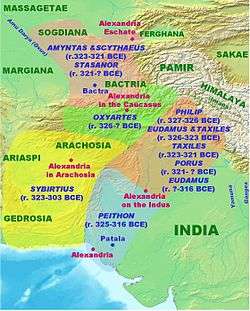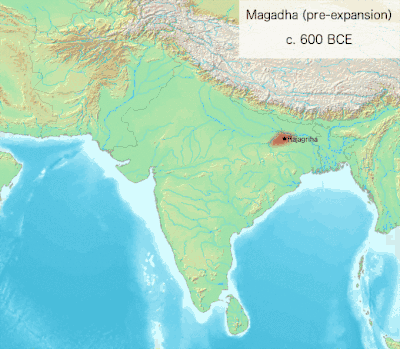Seleucid–Mauryan war
The Seleucid–Mauryan War was fought between 305 and 303 BCE. It started when Seleucus I Nicator, of the Seleucid Empire, sought to retake the Indian satrapies of the Macedonian Empire which had been occupied by Emperor Chandragupta Maurya, of the Maurya Empire.
| Seleucid–Mauryan War | |||||||
|---|---|---|---|---|---|---|---|
 Alexander the Great's Satrapies in Northern India. | |||||||
| |||||||
| Belligerents | |||||||
| Maurya Empire | Seleucid Empire | ||||||
| Commanders and leaders | |||||||
|
Chandragupta Maurya Chanakya | Seleucus I Nicator | ||||||
| Strength | |||||||
|
100,000 infantry 30,000 cavalry 9,000 elephants | 250,000 infantry | ||||||
| Casualties and losses | |||||||
| unknown | unknown | ||||||
The war ended in a settlement resulting in the annexation the Indus Valley region and part of Afghanistan to the Mauryan Empire, with Chandragupta securing control over the areas that he had sought, and a marriage alliance between the two powers. After the war, the Mauryan Empire emerged as the dominant power of the Indian Subcontinent, and the Seleucid Empire turned its attention toward defeating its rivals in the west.
Background

Chandragupta Maurya established himself as ruler of Magadha around 321 BCE. He decided to conquer the Nanda Dynasty, rulers at the time of the Gangetic Plain. He fought the empire for eleven years with successful guerrilla campaigns, and captured the Nanda capital of Pataliputra. This led to the fall of the empire and the eventual creation of the Maurya Empire under Emperor Chandragupta Maurya.
The Persian provinces in what is now modern Afghanistan, together with the wealthy kingdom of Gandhara and the states of the Indus Valley, had all submitted to Alexander the Great and become part of his empire. When Alexander died, the Wars of the Diadochi ("Successors") split his empire apart; as his generals fought for control of Alexander's empire. In the eastern territories one of these generals, Seleucus I Nicator, was taking control and was starting to establish what became known as the Seleucid Empire. According to the Roman historian Appian, Seleucus,
always lying in wait for the neighboring nations, strong in arms and persuasive in council, he acquired Mesopotamia, Armenia, 'Seleucid' Cappadocia, Persis, Parthia, Bactria, Arabia, Tapouria, Sogdia, Arachosia, Hyrcania, and other adjacent peoples that had been subdued by Alexander, as far as the river Indus, so that the boundaries of his empire were the most extensive in Asia after that of Alexander. The whole region from Phrygia to the Indus was subject to Seleucus.
Alexander had appointed satraps in control of his territories. Similarly satraps were appointed to govern the Indus Valley. The Mauryans had annexed the areas governed by four such satraps: Nicanor, Phillip, Eudamus and Peithon. This established Mauryan control to the banks of the Indus. Chandragupta's victories convinced Seleucus that he needed to secure his eastern flank. Seeking to hold the Macedonian territories there, Seleucus thus came into conflict with the emerging and expanding Mauryan Empire over the Indus Valley.[5]
War
Details of the conflict are lacking. Per Appian,
Seleucus crossed the Indus and waged war with Sandrocottus [Maurya], king of the Indians, who dwelt on the banks of that stream, until they came to an understanding with each other and contracted a marriage relationship. Some of these exploits were performed before the death of Antigonus and some afterward.
It is unknown if there was in fact a pitched battle.[4] Military historian John D. Grainger has argued that Seleucus, upon crossing the Indus, "would find himself in a trap, with a large river at his back and a hostile continent before him," and consequently could not have advanced much farther than the Indus. According to Grainger, the details of the conflict are unclear, but the outcome clearly must have been "a decisive Indian victory," with Chandragupta driving back Seleucus' forces as far as the Hindu Kush and consequently gaining large territories in modern-day Afghanistan.[6] According to Wheatley and Heckel, the level of friendly Maurya-Seleucid relations established after the war imply that the hostilities were probably "neither prolonged nor grievous".[3]
Consequences
Seleucus Nicator ceded the Hindu Kush, Punjab and parts of Afghanistan to Chandragupta Maurya.[7] In consequence of their arrangement, Seleucus received 500 war elephants from Chandragupta Maurya, which subsequently influenced the Wars of the Diadochi in the west. Seleucus and Chandragupta also agreed to a marriage alliance, probably the marriage of Seleucus' daughter to Chandragupta.
The arrangement proved to be mutually beneficial.[8] The border between the Seleucid and Mauryan Empires remained stable in subsequent generations, and friendly diplomatic relations are reflected by the ambassador Megasthenes, and by the envoys sent westward by Chandragupta's grandson Ashoka. Chandragupta's gift of war elephants "may have alleviated the burden of fodder and the return march"[5] and allowed him to appropriately reduce the size and cost of his large army, since the major threats to his power had now all been removed.[9]
With the war elephants acquired from the Mauryas, Seleucus was able to defeat his rival, Antigonus, along with his allies at the Battle of Ipsus. Adding Antigonus's territories to his own, Seleucus would found the Seleucid Empire, which would endure as a great power in the Mediterranean and the Middle East until 64 BCE.
Mauryan control of territory in Afghanistan helped guard against invasion of India from the northwest.[10] Chandragupta Maurya went on to expand his rule in India southward into the Deccan.[7]
Notes
- Hartmut Scharfe (1971) had argued that Seleucus had gained the upper hand and retained overlordship of the eastern satrapies, which were put under Chandragupta's charge in exchange for the elephants as tribute; but according to Trautmann[2], no other scholars have agreed with this conclusion; Wheatley and Heckel state that Scharfe's argument "does not convince."[3]
References
- Grainger 2014, p. 108–109: "Such fighting as there was produced a decisive Indian victory. [...] There is little or no evidence for the [detailed] account [...] The career of Chandragupta is as unclear as that of Seleukos in the east."
- Trautmann 2015, p. 235.
- Wheatley and Heckel 2011, p. 296.
- Kosmin 2014, p. 33.
- Kosmin 2014, p. 34.
- Grainger 2014, p. 108–109
- [R.G. Grant: Commanders pg. 49 https://books.google.com/books?id=tFQcwH2StsMC&q=chandragupta#v=snippet&q=chandragupta&f=false]
- Kosmin 2014, p. 33–34.
- Grainger 2014, p. 110.
- Grainger 2014, p. 108,110.
Sources
- Grainger, John D. (2014), Seleukos Nikator: Constructing a Hellenistic Kingdom, Routledge, ISBN 978-1-317-80099-6
- Kosmin, Paul J. (2014), The Land of the Elephant Kings: Space, Territory, and Ideology in Seleucid Empire, Harvard University Press, ISBN 978-0-674-72882-0
- Majumdar, Ramesh Chandra (2003) [1952], Ancient India, Motilal Banarsidass, ISBN 81-208-0436-8
- Trautmann, Thomas (2015), Elephants and Kings: An Environmental History, University of Chicago Press, ISBN 978-0-226-26453-0
- Wheatley, Pat; Heckel, Waldemar (2011), ""Commentary (Book 15)"", Justin: Epitome of the Philippic History of Pompeius Trogus: Volume II, Oxford University Press, ISBN 978-0-19-927759-9